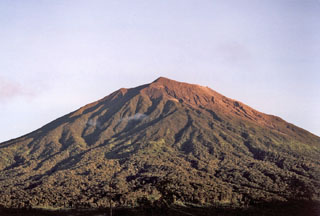Report on Kerinci (Indonesia) — 16 November-22 November 2016
Smithsonian Institution / US Geological Survey
Weekly Volcanic Activity Report, 16 November-22 November 2016
Managing Editor: Sally Sennert.
Please cite this report as:
Global Volcanism Program, 2016. Report on Kerinci (Indonesia) (Sennert, S, ed.). Weekly Volcanic Activity Report, 16 November-22 November 2016. Smithsonian Institution and US Geological Survey.
Kerinci
Indonesia
1.697°S, 101.264°E; summit elev. 3800 m
All times are local (unless otherwise noted)
Based on satellite data, the Darwin VAAC reported that during 16-19 and 21 November ash plumes from Kerinci rose to altitudes of 4.3-4.6 km (14,000-15,000 ft) a.s.l. and drifted NE, ENE, SE, and S. Plumes drifted almost 30 km on 17 November.
Geological Summary. Gunung Kerinci in central Sumatra forms Indonesia's highest volcano and is one of the most active in Sumatra. It is capped by an unvegetated young summit cone that was constructed NE of an older crater remnant. There is a deep 600-m-wide summit crater often partially filled by a small crater lake that lies on the NE crater floor, opposite the SW-rim summit. The massive 13 x 25 km wide volcano towers 2400-3300 m above surrounding plains and is elongated in a N-S direction. Frequently active, Kerinci has been the source of numerous moderate explosive eruptions since its first recorded eruption in 1838.

